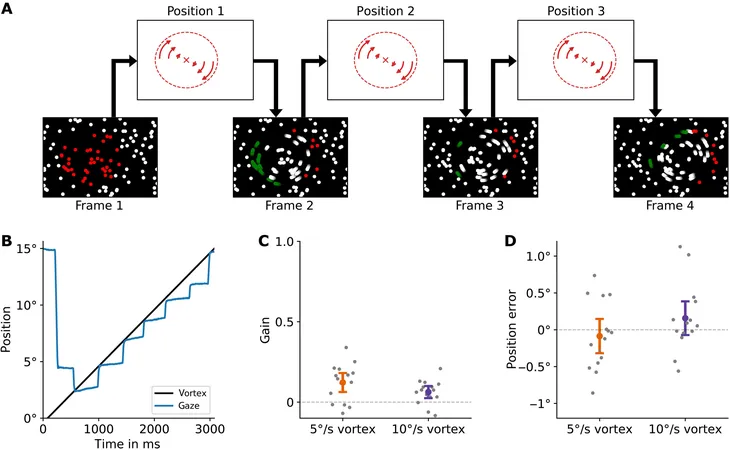
Groundbreaking Eye-Tracking Study Unveils Secrets of Visual Stability
2024-11-07
Author: Siti
Groundbreaking Eye-Tracking Study Unveils Secrets of Visual Stability
In an astonishing revelation, scientists have uncovered the retinal mechanisms fundamentally involved in how we perceive a stable world despite our constant eye movements. Each second, our eyes gather more than 10 million pieces of information, transmitting this data through thousands of nerve fibers to the brain, creating an illusion of a seamless experience in a rapidly changing environment.
Research Overview
Led by the innovative psychologist Prof. Markus Lappe from the University of Münster, a research team delved into the mysteries of visual perception, specifically focusing on how we perceive motion in non-rigid objects like fire and water. This area has remained largely unexplored, prompting an exciting investigation into how our highly dynamic visual input signals contribute to our perception of stability.
Key Findings
Contrary to longstanding beliefs within vision science, the team discovered that smooth eye movements, known as smooth pursuits, are not universally applicable to all types of visual motion. Their groundbreaking research also highlights that the brain’s compensation for rapid eye movements, known as saccades, is disrupted when observing certain non-rigid movements, leading to a loss of visual stability.
Significance of the Research
These significant findings were published in the esteemed journal, Science Advances, sparking intrigue within the scientific community.
Expert Insights
Prof. Lappe noted a critical distinction revealed by their research: “Our results show a clear separation of the two systems. They are functionally distinct and operate via different neuronal pathways.” This insight challenges the conventional understanding that rapid and smooth eye movements respond similarly to visual stimuli.
Visual Motion Illusion
The researchers demonstrated a newly identified visual motion illusion that disrupts spatial perception, further illustrating their findings. During the study, 15 participants were tasked with tracking a simulated rotating vortex across a backdrop of dots. Typically, such tasks are straightforward, allowing the eyes to remain fixed on moving objects. However, participants struggled to track the vortex, leading to a phenomenon where their eyes would remain static for portions of time.
Study Mechanics
This disconnect was particularly evident every 400 milliseconds when rapid eye movements were triggered, abruptly realigning the vortex in the center of participants' visual fields, which caused the vortex to appear to jump dramatically.
Participant Experience
Ph.D. student Krischan Alexander Koerfer explained, "While the movement was perceptible, the eyes simply couldn't follow it as expected. This represents a previously unidentified phenomenon that disrupts our usual compensatory mechanisms."
Technical Approach
To further explore this relationship, the researchers meticulously measured eye position and movements using advanced high-speed infrared cameras, known as eye trackers. These devices illuminate the eyes with infrared light and capture reflections on the cornea and pupil, enabling precise analysis of eye dynamics.
Future Implications
This study not only broadens our understanding of visual stability but also heralds new possibilities for addressing visual perception issues in both clinical settings and technological applications, paving the way for further research into how we interact with the fluidity of our surroundings.
Conclusion
The quest to unravel the complexities of human vision continues, with implications that could revolutionize fields ranging from virtual reality to neuroscience. Stay tuned for more astonishing breakthroughs in the understanding of our perception of reality!



 Brasil (PT)
Brasil (PT)
 Canada (EN)
Canada (EN)
 Chile (ES)
Chile (ES)
 Česko (CS)
Česko (CS)
 대한민국 (KO)
대한민국 (KO)
 España (ES)
España (ES)
 France (FR)
France (FR)
 Hong Kong (EN)
Hong Kong (EN)
 Italia (IT)
Italia (IT)
 日本 (JA)
日本 (JA)
 Magyarország (HU)
Magyarország (HU)
 Norge (NO)
Norge (NO)
 Polska (PL)
Polska (PL)
 Schweiz (DE)
Schweiz (DE)
 Singapore (EN)
Singapore (EN)
 Sverige (SV)
Sverige (SV)
 Suomi (FI)
Suomi (FI)
 Türkiye (TR)
Türkiye (TR)
 الإمارات العربية المتحدة (AR)
الإمارات العربية المتحدة (AR)